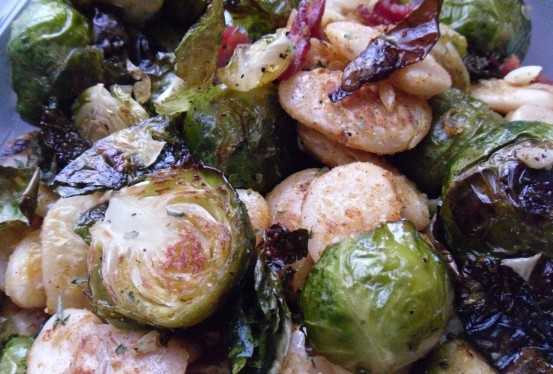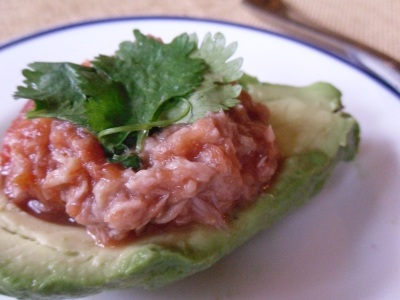
Giant Lima Beans & Brussels Sprouts: Shown here with lean turkey bacon. Here are 3 versions: 1. Con carne- With crisp, lean, nitrate-free turkey bacon 2. Vegetarian- With thin shavings of aged Parmesan or aged sharp white cheddar. 3. Vegan- With an extra dash of salt and 2 extra garlic cloves (or with soy bacon if preferred)
Pan-Seared Peruvian Giant Lima Beans
with Roasted Brussels Sprouts
Inspired by Gigante Beans, a dish from Ziziki’s Taverna in Addison, this dish prepares beans in a whole new light. The pan-seared, garlic-rich flavor is spiked with savory tastes that make these beans anything but bland.
Ingredients
Serves 2
-12 fresh brussels sprouts, rinsed and sliced in halves
-6-8 cloves fresh garlic
-About 3/4 cup dry Giant Peruvian Lima Beans
-4 cups water
-3-4 slices lean, nitrate-free turkey bacon (or alternative)
-4 tbsp olive oil
-dash of turmeric
-dash of paprika
-dash of ground cloves (optional)
-pinch of salt and ground black pepper
Method
BEANS: 1) Soak beans overnight (or for at least 4 hours) in about 4 cups water. Follow the instructions on the package as this may vary slightly with the variety of ginat lima beans. 2) Next, bring beans to a boil and reduce to a high simmer for 1 hour. Check on them to make sure that the water does not evaporate too quickly. If the water becomes very low, add more. 3) Drain beans and add to saucepan with 2 tbsp olive oil and 5 cloves minced garlic. Stir frequently. Sear for about 5 minutes.
B. SPROUTS: 1) Preheat oven to 350°F. Rinse brussels sprouts and cut into halves. Add to a baking tray with 2 tbsp olive oil, a dash of ground black pepper and a very slight dash of salt. I have found that you can use less salt and taste it more if you primarily add it after cooking. Add in 3 cloves minced garlic after the brussels sprouts have already cooked for about 15 minutes. Bake for 30-40 minutes total, shaking tray or stirring with a spatula every 15 minutes.
T. BACON: 1) Preheat oven to 400°F. Follow your bacon’s package instructions. I used lean nitrate-free turkey bacon. Cooked for 17 minutes at 400°F. You can prepare the bacon the day before and keep in fridge to use for recipe the next day. You only need about 3 pieces of bacon for this recipe; it is meant to accentuate the flavors not overpower them. Here is a recipe to try with the leftover bacon strips: Bacon-Wrapped Dates. Otherwise, store in the fridge and use to top soups or salads. Vegetarians and vegans feel free to sub out the bacon for another savory flavor such as from the suggestions below.
PUTTING it all TOGETHER: Combine ingredients in large saucepan and serve hot! Store leftover in the fridge for up to 4 days for best freshness. Re-heat in microwave-safe ceramic bowl or plate (for about 1 min 30 seconds) or reheat the portion you will use on the stove top.
Here are 3 versions:
1. Con carne- With crisp, lean, nitrate-free turkey bacon
2. Vegetarian- With thin shavings of aged Parmesan or aged sharp white cheddar.
3. Vegan- With an extra dash of salt and 2 extra garlic cloves (or with soy bacon if preferred)



